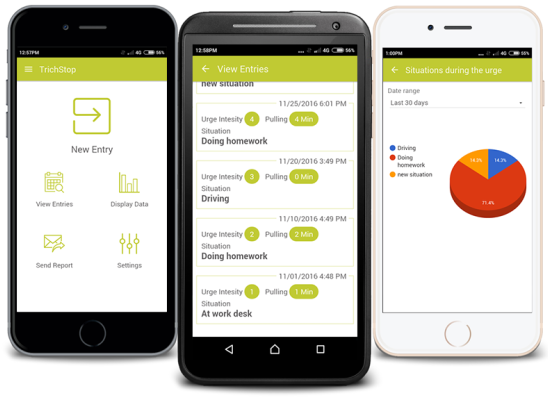Habitaware - Breakthrough technology for habit awareness and BFRBs
Online test
Find out the severity of your symptoms with this free online test

image: Habitaware
Trichotillomania, or compulsive hair pulling is more than just a bad habit. It is a condition that causes the person engaging in the hair pulling immense shame and guilt, often preventing them from fully enjoying activities and interactions that would normally give their lives meaning. Research shows that cognitive behavioral therapy has the highest success rate in helping people with trichotillomania manage the urges to pull and therefore break free from the control this disorder has over them. However there are many different methods within the cognitive behavioral frame of reference, and it is often recommended that a holitic approach to treatment be taken. Just as the triggers for onset of trichotillomania and other BFRBs are different for each individual, so too would the effectiveness of different treatments be different for each person. What works for one person, may not work for the next. However one commonality all treatments have, even among alternate therapies and natural remedies is that awareness of the behavior is key. If you don't know when you are pulling or what your triggers are, you cannot optimally apply the technique or strategy the treatment recommends. That is why habit awareness is one of the critical first steps to overcoming the urge to compulsively pull your own hair.
Habit awareness through technology
We at Trichstop are very excited by this new development in the technology world that is aimed at helping people become more aware of their behaviors. One of the methods we employ in our online therapy program is called Habit Reversal Therapy. It is the first stage of the program is designed to help the individual become more aware of their pulling behaviors so as to understand what their triggers are. There are 2 types of hair pulling:
- focused pulling: the person is aware of the urge to pull first and then consciously engages in pulling in response to the urge
- automatic: the person is not aware of an urge to pull, subconsciously engaging in the pulling, often catching themselves in the act after they had already been pulling for some time.
We often ask clients to keep a pulling log, noting down when, where, how, how long, under what circumstances they start pulling, and what they are thinking and feeling at the time and just prior to pulling. For those who engage in focused pulling it is easier to keep this log than for those who pull automatically. But finally there is a device to help make this process easier and is the brainchild of a woman who had trichotillomania for 20 years without telling a soul, and her husband who eventually discovered her secret. The device call Liv by Habitaware is the world’s first smart subconscious-behavior tracker and awareness trainer. Liv is customized to your specific behavior. Liv's vibration gently reminds you when you are doing the behavior you don't want to be doing.
Habitaware: The beginning
Body focused repetitive behaviors (BFRBs) like trichotillomania and dermatillomania are some of the most under-diagnosed mental disorders due to the lack of awareness about it. The physical consquence of repetitively pulling ones own hair causes the person immense shame and embarrassment so people with trichotillomania, like co-founder of Habitaware Aneela Kumar, often suffer in silence, going to great lengths to hid the evidence of their shame. It was only when Aneela married Sameer Kumar and he one day discovered that she had no eyebrows that she decided to tell someone the secret she had kept for 20 years. Together they set about helping her overcome this behavior and so Liv by Habitaware was born. In May 2016 Habitaware launched Liv for pre-order and are on track to have final testing, assembly and shipping ready by December 2016! Thus far the device has received rave reviews from those who were involved in the Beta testing stage and has been endorsed by the TLC Foundation for BFRBs. According to Carol Novak, who is the Managing Director and on the Scientific Advisory Board of the TLC Foundation:
This technology is a breakthrough. Many professionals have dreamed of having this type of bracelet for years to help people with hair pulling, nail biting and other similar behaviors. It also has huge potential for research.

image: Habitaware
How does it work?
So how does the device work? Liv uses smart technology. We all use apps on our mobile phones and tablets. It works in a similar way to fitness training tracker devices, except this device is specifically designed to recognize up to 8 specific actions or behaviors.
- Step 1: With a one-time training process, Liv learns to recognize the behavior you want to stop
- Step 2: Liv’s app gives you a beautiful visualization of your behavior, helping you track progress and identify triggers
- Step 3: Liv's app also suggests timely strategies so you can replace the behavior with healthier ones
This will be incredibly helpful in the Habit Awareness stage of cognitive behavioral therapy as it goes hand in hand with identifying when you are about to pull and competing responses, whereby you identify behaviors that you can use in response to the urge to pull that interferes with your ability to pull.

image: Habitaware
Early days
As much as we are very excited about this incredible technological breakthrough in the treatment of BFRBs, we are also aware that it is still in its early stages. As with anything new there will no doubt be kinks to iron out and issues to resolve. For instance have they addressed issues of privacy of data and information about the person wearing it and how strong the effect remains over an extended period of time. But we will be keeping a close eye on the development of this product as we see great potential in the difference it will make in the lives of many people sufferring from BFRBs the world over.
Online test
Find out the severity of your symptoms with this free online test
Start your journey with TrichStop
Take control of your life and find freedom from hair pulling through professional therapy and evidence-based behavioral techniques.
Start Now



